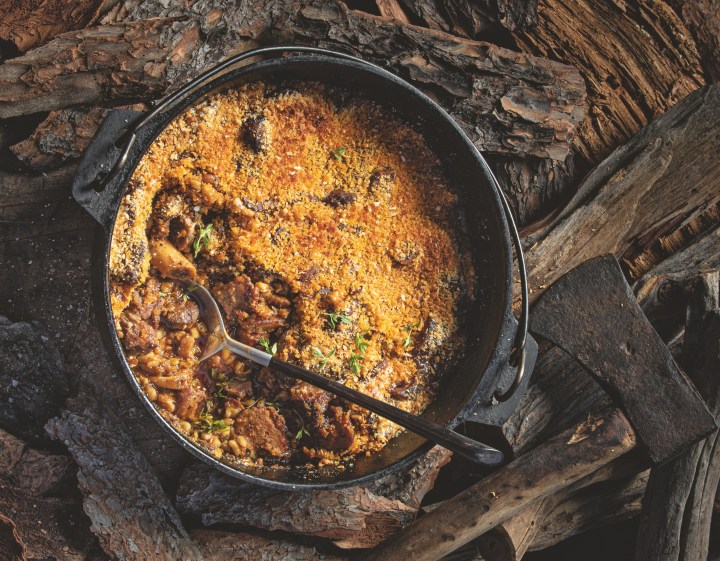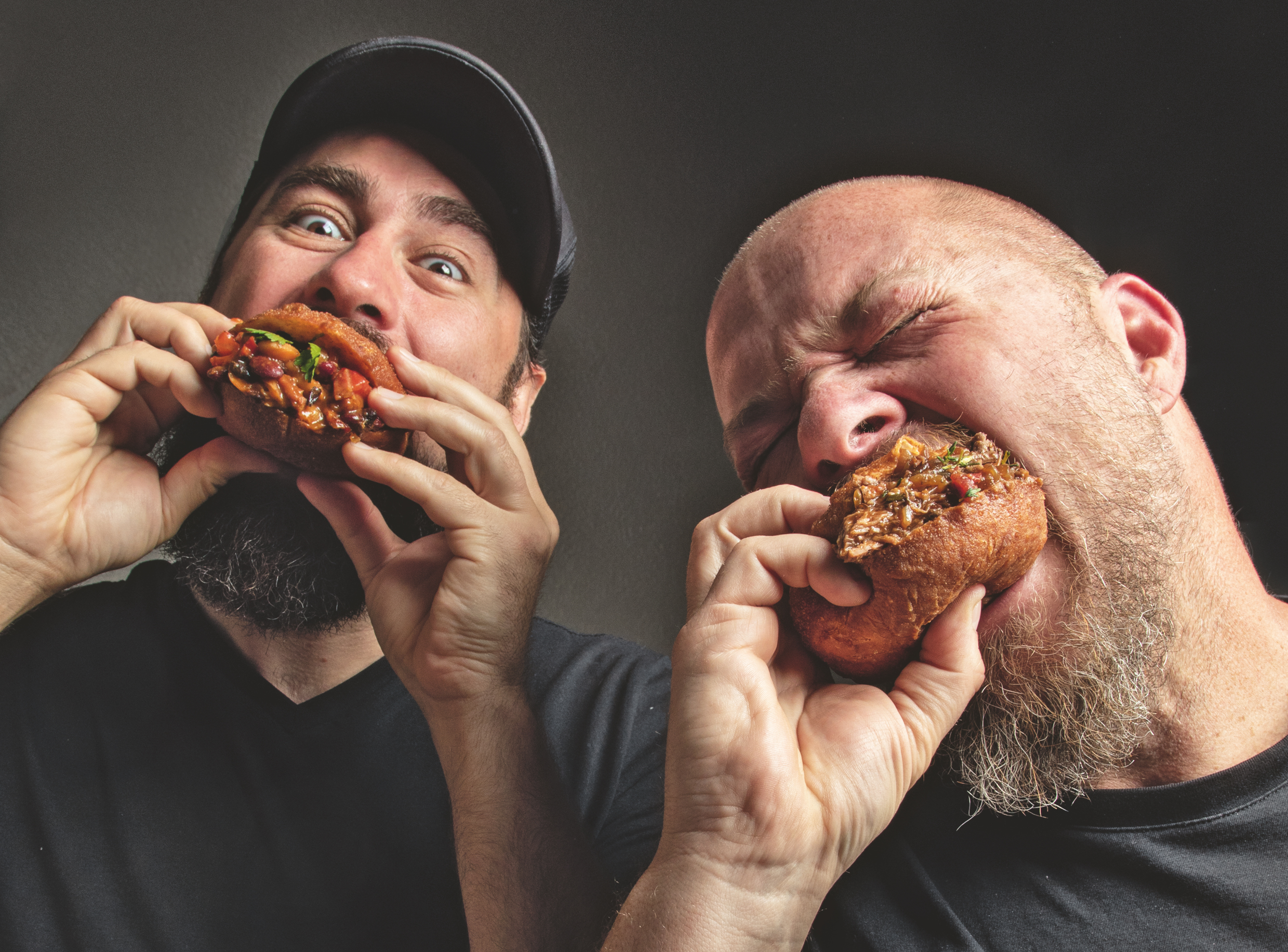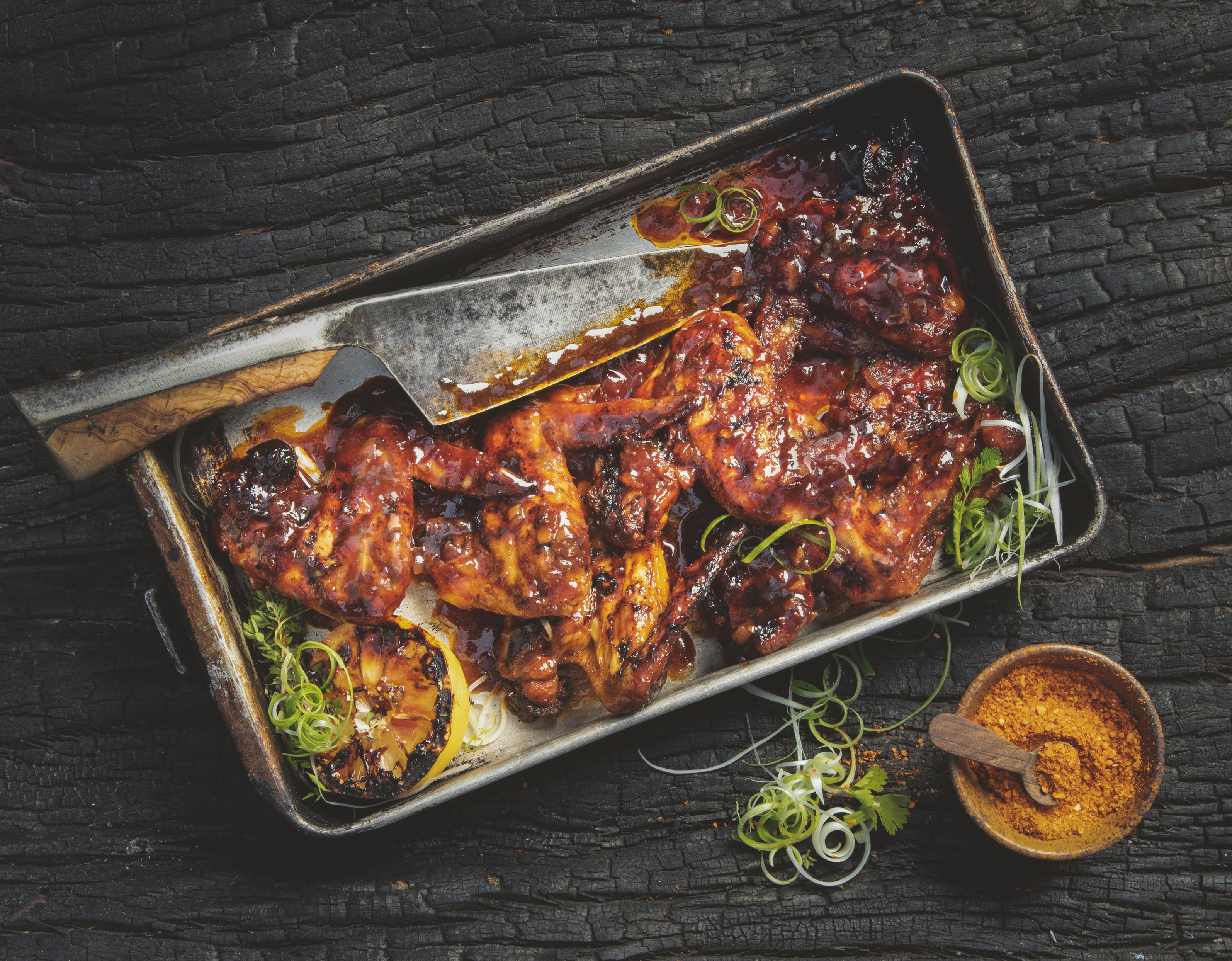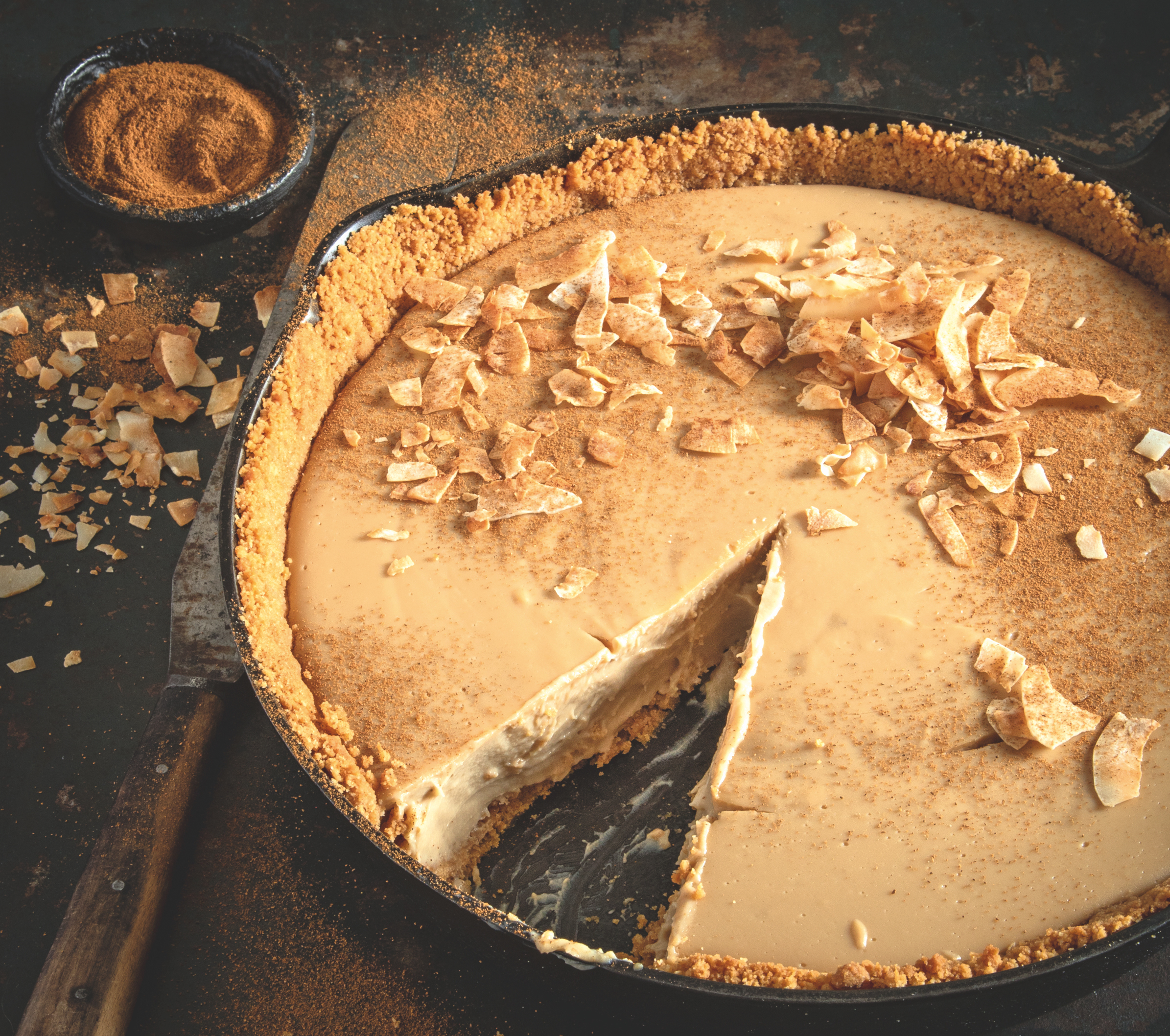POTJIE OF GOLD
A cast iron love story that lifts the lid on the three legged pot

First they published a book called Beer Food Fire; now Karl Tessendorf and Greg Gilowey – collectively, Beer Country – are back with Pots Pans & Potjies.
No other cookware conjures up mental images of searing steaks and winter nostalgia like cast iron. In fact, it’s almost impossible for any red-blooded braaier to walk past a cast-iron pan without sagely commenting to their mate that it looks like it would cook a mean steak.
Thus opens chapter one of Pots Pans & Potjies. It’s a perfectly valid statement, but then if each mate goes on to suggest, in their opinion, how said steak should be cooked, well that could test a friendship if methods are not in accord. Families have feuded over less.
As much as it’s part of our very essence, the thing that connects us and brings us together, the braai can be divisive. I’ve chewed on well done lamb chops salted with my bitter tears, and in turn, served pink skilpadjies to someone who cannot abide anything faintly raw. I know someone who will not braai their own meat if someone else has made and tended the fire. There was that time a man (yes) forcibly relieved me of my tongs and proceeded to transform my chicken sosaties into dried nuggets on a stick.

Karl Tessendorf and Greg Gilowey are, collectively, Beer Country, and these men know how to make fire more than a heat source. It’s an ingredient. (Photo: Louis Hiemstra)
At least I know how to make a fire, and Beer Country (they came second in the first season of Ultimate Braai Master in 2011) is to thank for that. It’s not a secret: begin with charcoal (never briquettes), kindling and firelighters. The base this forms is virtually foolproof for any wood you lay on top of it. Obviously, you need to do your best to procure dry wood. That wet hissing is soul destroying.
Back when BFF came out in 2019, I interviewed Karl Tessendorf and Greg Gilowey, and we got on splendidly. We had a lot of fun that day and parted with enthusiastic promises to braai together. My intentions, as were theirs I’m sure, were good but as is so often the case, it never happened. Then I found out there was a second book which should be on the shelves in time for Father’s Day on Sunday although there are plenty of female folks who’d love it too – I collared Greg and invited myself to his house for a braai. Because at the time I thought the book was a sequel.
But no! It’s a companion. Pots Pans & Potjies is a cast iron love story. It will inform you of the history behind our beloved three-legged little cauldrons, how to look after them, even how to restore them, and most important, how to cook in them. While the potjie is something of the hero we are all familiar with, those other pots and pans get their chance to shine too.
However, be prepared to take your potjie game to the next level. There are rules, and we all know what they’re meant for, right?
“What makes a potjie a potjie? Like most things in life, if you ask five different people, you’ll get five different answers,” it says in the book. “The purists will tell you that the ingredients must be layered, that you should never stir, and if you can hear it bubbling, then it’s boiling too rapidly. At the other end of the spectrum, you’ll find people making pots that are boiling away with more speed than a trekker ever saw in a day of trekking.
“We believe that when it comes to building a potjie, the sweet spot is somewhere in the middle. With a nod to the past and an eye on the horizon, guidelines are there to be pushed and developed into new tasty avenues. Your potjie is a playground, so be bold. Don’t be afraid to try new things, but always remember the one rule as decreed by the Great Potjie Pot in the sky – it’s only a potjie if you’re cooking over fire.”
The intent of the book is to shift the mentality about what a potjie pot is, said Greg. “It’s so much more than something for braising meat and adding layers and putting cabbage leaves on top. The potjie is a playground. You’re not going to break it, it’s not called the rough tough black stuff for nothing!” he laughed. “We hope to ruffle a few feathers and open up what you can do with cast iron on a fire.”

The oh-so-wonderful chicken wings that Bianca cannot get enough of. (Photo: Louis Hiemstra)
And so it came to pass; I was given a copy of the book and allowed to choose some recipes I fancied trying. Greg had already mentioned Monkey Gland Potjie Wings, from which I would not be swayed. With so many delicious-sounding – and -looking, the photographs are as amazing as in the first book (same guy, Louis Hiemstra) – I batted the ball back into their court.
Whatever your favourites are, I said. “Our favourite recipe is whichever one you turn into a family favourite recipe. That’s good enough for us,” said Greg. “We cook all the recipes in the book, and we know they’re lekker. But we cook some more than others.”
The menu they decided on was the chicken wings, Braaied and Crusty Cape-ssoulet, Karoo Lamb Potjie, and Chai Rooibos Coconut Milk Tart. Okay, the dessert doesn’t have to be made on the fire, unless you really want to cook custard over the coals, but it’s in the book, and the most difficult thing is blind baking the crust.
A clue from the title of the first book is that Karl and Greg love beer. Sadly, I do not. But with plenty of options in the fridge, Greg was undeterred and set about finding something I would enjoy. Because how else are you supposed to sit or stand around a fire?
Given that potjie-making is a process of several hours, they guys had done a lot of earlier and upfront preparation. The chicken wings were magnificent. They’re a quick cook – colour/char/caramelise over hot coals, and pop them into the sauce in the potjie for an hour or so. Serve sprinkled with finely chopped spring onions. They put the “suck” in succulent; the meat slides off the bones. The only reason I didn’t have more was because of the dishes that were to follow.

Lamb knuckle. Gravy. Dumplings. This is the Karoo Lamb Potjie – a great one to make as a first-timer. (Photo: Louis Hiemstra)
The recipes are meant to be adapted and modified. It’s not the science of baking. That said, sometimes things can go wrong and your potjie is meh. This book has got your back with all the tips and tricks to rescue an iffy sauce or flavour, plus loads of other helpful information. Like we all know to hold our hands over the coals and nod sagely, and say “not quite yet”. In the book, it breaks down the different temperatures and – this is revolutionary – how many seconds you have to hold your hand there. Life changing. Also necessary for potjies.
“The thing with the book is that it’s not the finish line, it’s the starting blocks,” said Greg (who is the talkative one). “So we’ve given you a good base to work from and we’re not precious about it, so go ahead – fool around, don’t be scared. We’ll get you out the gate. Getting over the finish line is up to you.”
The Karoo Lamb was rich and served with dumplings which bubbled in the gravy at the end of the cooking time; Braaied and Crusty Cape-ssoulet is Greg’s invention, a take on classic French cassoulet. Here, the meats are braaied – lamb knuckles, pork rashers, pork sausages – followed by a saucy potjie element. Then in go samp and beans, for a period of “whispering” (it’s a whole language of its own I tell you). Breadcrumbs (in this case Karl’s own-made sourdough) and Parmesan cheese go on top, lid on, coals on, until crisp and golden.

It’s the same milk tart from the first book, but bumped up with some aromatic chai rooibos. (Photo: Louis Hiemstra)
The milk tart was gorgeous and I was very happy with the state of my mouth and my belly, but Greg insisted I also try the pecan and pear crumble with blue cheese ice cream. “What if we made a dessert that was kinda like a sweet, buttery crumble and kinda like a funky creamy cheese board? Sounds crazy. Let’s try it,” says the recipe, and I think that last bit pretty much sums up these guys. There’s a sense of fun and adventure in their food and their book, and that reflects their personalities. And I have to say, I don’t care if they blush, that there’s something enormously attractive about men who are not chefs but flipping good at and passionate about cooking. We talked in depth about the food, and debated different types of wood, among many other things, including something dreadful that is being done to Tolkien.
As darkness fell, and we sat companionably around the fire, I mused out loud that to round out this story, I should make my own first potjie. But first I needed a potjie.
Longish story slightly shorter, I found one. A tiny number one, umber with rust. Potjies such as these languish in sheds and workshops, sometimes finding their way to car boot sales. The good news is they can be fixed. The book will tell you how. I Whatsapped Greg with great excitement.
“Now if only you knew a guy who knows a guy who wrote a book on bringing forgotten cast iron back from the dead?” he replied.
And that’s what happened. The transformation was incredible, and I am eternally grateful. Greg even said he loves fixing potjies so who am I to stand in his way?
“If it gets one – just one – forgotten potjie off a garage shelf and out into the coals, being used to make epic fire food, that’s good enough for me. Then the book’s a win and everything else is gravy,” said Greg.
That it happened even before the book came out was even better.
One fine Sunday, I lit a fire and made a High Elf Oxtail Potjie. It’s actually “Highveld” in the book but through the joys of autocorrect it will now and forever be known as High Elf. I enjoyed it thoroughly – the prep, the cooking (three hours, one drinks quite a bit of wine), and the eating. Oh and most definitely the leftovers. Next, I’m doing those chicken wings that I can’t get out of my mind. DM/TGIFood
Follow Bianca Coleman on Instagram @biancaleecoleman
The writer supports The Gift of the Givers Foundation, the largest disaster response, non-governmental organisation of African origin on the African continent.



 Become an Insider
Become an Insider
Comments - Please login in order to comment.